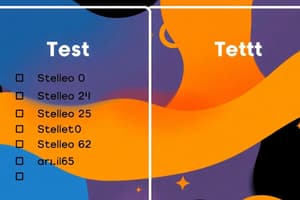Podcast
Questions and Answers
Black-box testing is usually based on some form of ______.
Black-box testing is usually based on some form of ______.
specification
Common features of black-box test techniques include: Models ( are created during test ______ ) and test _____ (are derived systematically from these models)
Common features of black-box test techniques include: Models ( are created during test ______ ) and test _____ (are derived systematically from these models)
design, conditions
Completely fulfilling the ______ criteria does not mean that the entire set of tests is complete.
Completely fulfilling the ______ criteria does not mean that the entire set of tests is complete.
coverage
Test conditions are derived systematically from these ______.
Test conditions are derived systematically from these ______.
Deriving tests from the ______ is often part of testing the behavior of the system.
Deriving tests from the ______ is often part of testing the behavior of the system.
Black-box test techniques target different types of software and ______.
Black-box test techniques target different types of software and ______.
Equivalence partitioning (EP) is a technique used to reduce the number of test cases required to effectively test the handling of ______, output, ____ value and ___-related value
Equivalence partitioning (EP) is a technique used to reduce the number of test cases required to effectively test the handling of ______, output, ____ value and ___-related value
By selecting one representative value from a partition, coverage for all the items in the same ______ is assumed.
By selecting one representative value from a partition, coverage for all the items in the same ______ is assumed.
An equivalence partition can be any non-empty set of ______.
An equivalence partition can be any non-empty set of ______.
EP is strongest when used in combination with ______ value analysis.
EP is strongest when used in combination with ______ value analysis.
EP, using values from the valid partitions, is commonly used for ______ testing a new build or ____.
EP, using values from the valid partitions, is commonly used for ______ testing a new build or ____.
This technique is applicable at any test ______.
This technique is applicable at any test ______.
Flashcards are hidden until you start studying
Study Notes
Black-Box Test Techniques Overview
- Black-box testing focuses on examining the functionality of a software application without knowledge of internal code structure or implementation details.
- Test design often utilizes models such as state transition diagrams and decision tables to lay out test conditions systematically.
Test Condition Derivation
- Test conditions are derived from models created during the test design phase.
- Coverage criteria from test techniques measure both test design and execution activities, ensuring a systematic approach to testing.
Coverage Criteria and Test Completeness
- Meeting coverage criteria indicates that no additional tests can significantly increase coverage according to the applied test technique.
- Fulfillment of coverage criteria does not guarantee overall test completeness; it only suggests that the model has been adequately explored.
Requirement Specifications
- Black-box testing typically relies on specification documentation, including system requirement specifications or user stories that outline expected behaviors.
- The absence of explicit specifications may lead testers to infer requirements, such as when replicating the functionality of legacy systems.
Variety of Techniques
- Numerous black-box test techniques exist, each designed for specific software types and contexts.
- Each technique has unique applicability, potential limitations, challenges for Test Analysts, coverage measurement methods, and specific defect focus areas.
Equivalence Partitioning (EP) Overview
- Technique for minimizing test cases while effectively assessing inputs, outputs, internal values, and time-related values.
- Involves creating equivalence partitions, also known as equivalence classes, from value sets that are processed similarly.
- One representative value from an equivalence partition can cover all items within that partition in testing.
Applicability of Equivalence Partitioning
- Suitable for any level of testing when all values in a set are expected to be treated uniformly.
- Applicable in scenarios where value sets are independent and do not interact.
- Can consist of various types of non-empty value sets: ordered, unordered, discrete, continuous, infinite, finite, or singleton.
- Valid and invalid partitions can be tested; invalid ones contain values that should not be accepted by the software.
Techniques and Combinations
- When combining equivalence partitions from different parameters, various techniques can enhance the testing process.
- Best utilized alongside boundary value analysis, which focuses on values at the edges of partitions to broaden test coverage.
- Commonly employed in smoke testing of new builds or releases to quickly ascertain if essential functionality operates correctly.
Valid and Invalid Partitions
- Selection of sets of values is relevant for both valid and invalid partitions in testing scenarios.
- Valid partitions consist of groups that meet certain criteria, while invalid partitions include groups that do not meet these criteria.
Handling of Sets of Values
- Important when all members of a set are expected to be processed uniformly by the system under test.
- Ensures that the application consistently handles various input categories or conditions.
Application Context
- Selection of value sets is crucial when the values used by an application do not have interactive effects on one another.
- This separation allows for clearer testing outcomes, as each value can be assessed independently without interference from others.
Studying That Suits You
Use AI to generate personalized quizzes and flashcards to suit your learning preferences.




